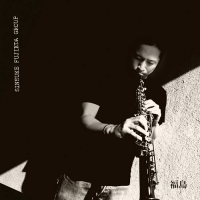Home » Jazz Articles » Extended Analysis » Marion Brown: Marion Brown: Why Not?
Marion Brown: Marion Brown: Why Not?
 Marion Brown
Marion Brown Why Not?
ESP-Disk
2009 (1966)
While the term "fire music" has held sway as a descriptor of the music of post-John Coltrane/Albert Ayler saxophonists from the 1960s onward, it's long been an incomplete summation of the work of most of these musicians. Alto saxophonist Marion Brown appeared on Coltrane's Ascension and tenor man Archie Shepp's Fire Music (both Impulse, 1965) and his playing was early on championed by poet/critic LeRoi Jones. His first recording as a leader, for ESP in 1965, was a spirited post-Coleman pianoless group with trumpeter Alan Shorter, tenor man Bennie Maupin, bassists Reggie Johnson and Ronnie Boykins and drummer Rashied Ali. The recording moved effortlessly between the poles of bouncy, Latinate blues and a more urbane freedom, but Brown's tight, squirrely sound wasn't without a sense of melody and a penchant for gentle, folksy exploration.
Like Coltrane and saxophonist Pharoah Sanders, Brown's brand of "free music" often necessitated the harmonic underpinnings of a piano or a guitar. After an aborted and unreleased session for the tiny, short-lived Pixie label, Brown returned to the ESP studio with his working quartet on October 23, 1966 to wax Why Not?. Rashied Ali sat in the drum chair otherwise occupied by the excellent Bobby Kapp, while bassist Norris "Sirone" Jones and pianist Stanley Cowell rounded out the unit.
The most immediately striking thing about Why Not? is its utter and complete dedication to both wistful, romantic lyricism and the edgy, insistent "cry." There are few recordings in this music which balance hunger and fullness so well. The theme toys with an expansive, Coltrane-like keen and ebullient, skipping Latin rhythms, Brown switching between a liquid purr and clipped barks. Cowell is the first soloist on what was one of his earliest recordings, lushly orchestral arcs clambering a poised modal staircase as Sirone and Ali follow an independent yet wholly relational path. Brown's solo is playfully loquacious, tugging at notes with hiccups and flourishes until he reaches a long, palate-cleansing passage of high harmonic squeals. Like fellow altoists Ornette Coleman, Prince Lasha and Eric Dolphy, the building of a solo across bar lines is natural and approximates speech-like cadences toward poetic bubblings-over.
The stately ballad "Fortunato," reprised on Three for Shepp (Impulse, 1966) and La Placita (Timeless, 1977) is a tense caress, an aching lament hanging in midair with occasional punctuated agitation. The theme itself recalls altoist Jackie McLean's rendition of "Poor Eric" on Right Now (Blue Note, 1965) in its eulogistic cries and the skittering eddies of light dissonance underneath the altoist's statements. Following the mashed arpeggios and trills of the title piece, the quartet closes with "Homecoming," a processional that gives Cowell room to stretch his free stride (not unlike peer Dave Burrell) into nose-dives and surging architecture. Known more for his work in trumpeter Charles Tolliver's progressive post-bop group Music Inc., it's a gas to hear him in a freer context. With the support of bass and drums, Brown's phrases dig in their heels with a peppery grit, martial calls-to-arms elevating into curlicues and winking abstractions in the mode of a lighter Sonny Rollins before Ali expounds on the theme, a testament to his then-growing abilities as a highly melodic drummer.
There's another story behind Why Not?, however, and that is of its curious cover images, taken upon Brown's arrival in Europe in late 1967. Photographer Guy Kopelowicz says: "the photo on the cover was taken in September shortly after Marion arrived in Paris. On the day of the photo shoot, Daniel Berger drove Marion and I in his 2CV Citroen. We started from central Paris and headed to the Place de la Concorde at the bottom of the Champs-Elysees. Marion was delighted in having a tour of the city and managed to avoid being hit by passing cars as he walked around for vantage positions of the fountains and the Eiffel Tower. He also enjoyed the ice cream that was being sold by a vendor on the Place [as reproduced on the Base Records reissue of Brown's ESP debut].
"At the corner of the Rue Washington, near the Arc de Triomphe, there was a huge publicity poster depicting the red and blue Bonnet Phrygien, the headwear of participants in the French Revolution. The poster had a 'Revolutionnaire' sign and was a teaser for a publicity campaign for an undisclosed product. Berger thought it might be worth a try to have photos taken of Marion in front of the colorful poster with a revolutionary attitude over what looked like a mini barricade."
The back cover image of Brown and his saxophone was also taken by Kopelowicz, at a concert at the American Center in Paris, where he was playing with his cooperative group with German vibraphonist and multi-instrumentalist Gunter Hampel. By the time Marion Brown's music started to get attention—he recorded two larger groups for the Fontana and Impulse! labels before leaving New York—the intrepid saxophonist was already off to Europe to find appreciation.
Tracks: La Sorella; Fortunato; Why Not?; Homecoming.
Personnel: Marion Brown: alto saxophone; Stanley Cowell: piano; Sirone: bass; Rashied Ali: drums.
Track Listing
La Sorrella; Fortunato; Why Not?; Homecoming.
Personnel
Marion Brown
saxophone, altoMarion Brown: alto saxophone; Stanley Cowell: piano; Norris "Sirone" Jones: bass; Rashied Ali: drums.
Album information
Title: Why Not? | Year Released: 2010 | Record Label: ESP Disk
Tags
PREVIOUS / NEXT
Support All About Jazz
 All About Jazz has been a pillar of jazz since 1995, championing it as an art form and, more importantly, supporting the musicians who make it. Our enduring commitment has made "AAJ" one of the most culturally important websites of its kind, read by hundreds of thousands of fans, musicians and industry figures every month.
All About Jazz has been a pillar of jazz since 1995, championing it as an art form and, more importantly, supporting the musicians who make it. Our enduring commitment has made "AAJ" one of the most culturally important websites of its kind, read by hundreds of thousands of fans, musicians and industry figures every month.


















